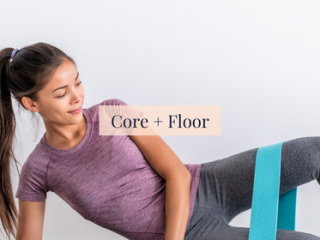You know that feeling, when you’ve left the physiotherapist’s (or chiropractor’s or doctor’s) office, reeling from a million medical terms? You know something is “wrong” but you feel confused and maybe even forgetful about the exact steps you’re supposed to take.
We’re so glad to see our mama clients getting care from Pelvic Floor Physiotherapists more and more these days. But sometimes — OK, we’d venture to say a lot of the time — we just need a little extra guidance when it comes to those invisible muscles down there.

Melanie Sutherland is a the clinic director of Body Co. and Registered Physiotherapist
As fitness professionals we know the importance of integrating what you learn lying on the exam table into your daily activities, especially as a mama carting around babies, kiddos and all their gear. Sigh.
So we sat down with one of our favorite Pelvic Health Physiotherapists, Melanie Sutherland of Body Co. to find out just how to bridge the gap between your physiotherapy assessment and your real #momlife.
what are some common pelvic floor symptoms you see in your mama clients?
Melanie: One thing I see a lot of in postpartum women is leakage. And when it comes to leakage there is an imbalance in the muscle tone of the pelvic floor. There are two types of pelvic floor muscle imbalances so you really do need to be assessed to see what’s going on with you. Women may experience either:
-
Hypotonic muscles – When the pelvic floor muscles are weakened and lack tone.
-
Hypertonic muscles – The pelvic floor muscles are too tense.
With hypotonic muscles there is a lack of support in the pelvic floor. So when you cough or sneeze and the timing is off, the muscle strength isn’t there to actually prevent the leakage.
If women experience a strong urge to go the washroom it’s possible there is excessive tension in the pelvic floor as well as pressure being placed downward due to restricted breathing mechanics.
A lot of clients get frustrated when I talk to them about releasing tension in their pelvic floor especially if they are experiencing symptoms because it’s a bit counter intutitive. We really do need to treat these two imbalances differently so you really do want to be assessed to find out what’s going on with you.
Pelvic Organ Prolapse is another common issue I see in postpartum women, which is when one of the pelvic organs is lower than it should be. Working on muscles imbalance and breathing mechanics as well as proper core engagement throughout your day can help with reducing the effects of pelvic organ prolapse.
There is really good research that with appropriate care and strengthening exercises we can improve the level of prolapse. Working under the supervision of a trainer specializing in postpartum movement will ensure you know when it is appropriate to move into different stages of physical activity.
so where do you start when trying to restore function to the pelvic floor?
Melanie: We tend to start with breathing, alignment and exercises that really support your core. Then we help clients take those aspects into what they do at home. So teaching people to notice their alignment throughout their day because we really do spend so much time slouching while feeding babies or working on the computer. We want to work toward a more neutral alignment meaning we want to stack the ribcage over top of the hips to allow the core muscles to work together more functionally.
Here are some of my favorite tips you can start to do throughout your day:
-
Breathing. Breathing is one of the first places I start with people when I see them. You want to focus on a full diaphragmatic breathing, feeling the breath side to side, front to back so the pelvic floor and diaphragm can move in a coordinated fashion.
-
Alignment. One of the exercises I give clients, that they both hate and love, is to bring their ribs over top of their hips, roll their shoulders down and back and feel like they are being pulled toward the ceiling from the top of their head EVERY time they walk through a doorway. You’d be surprised how many times a day you walk through a door frame!
Another great way to check out your alignment is to look at yourself in a mirror from the side and notice where your breasts are pointing. Are they lifted, looking down to the ground or perpendicular to the ground. We want to keep our ribs lowered, meaning your breasts should be straight forward, not up or down.
-
Notice your seated posture. Mamas spend a lot of time hunched over while feeding and rocking baby. One of my favorite tricks is to take a rolled up towel to the small of the back to prevent slouching. It feels great to have a little support at the lower back too.
-
Practice core engagement. It really is not enough to practice engaging your core 10 times in the morning while lying down on your back. We really need to practice engaging our core while doing every day movements like picking up baby or carrying the car seat.
-
Practice moving in a “neutral alignment”. Begin to feel a more neutral alignment in your body and then practice in every day positions. Take a moment to move in and out of the extreme positions (bum tucked under and untucked) and then finding neutral. Take a moment to recognize if you feel better there and then try moving in that position. Practice squatting in a neutral position or when holding baby.
what are some everyday activities that might contribute to to our physical issues?
Melanie: There is a lot of baby gear out there that really is not orthopaedically designed for parents that can possibly put us at risk of injury or discomfort.
-
Cribs, bathtubs
-
Car seats
-
Baby carriers
-
Rocking/reclining chairs
And there are a lot of movements that we take for granted throughout our day as well. For example, slouching in a chair while feeding baby or carrying baby around on one hip.
We really need to learn how to do everyday activities where there is a load, and guess what…your baby is a squirmy, little, adorable load! Using effective pelvic floor and core engagement during these everyday parenting activities will reduce the pressure on our bodies. Studies have shown that we really need be functionally engaging our core and pelvic floor repetitively throughout the day.

are there any other life style factors that may contribute to pelvic floor symptoms?
Melanie: Definitely!
-
Hydration. Women who are experiencing leakage may be cautious when it comes to staying hydrated especially when being physically active. I don’t want women to be scared of hydrating because there is always a reservoir of urine in your bladder, so emptying your bladder before an activity like running may not actually reduce the likelihood of leaking.
-
Bladder habits. Normal bladder habits are going to the bathroom 5-8 times a day, for a count of about 12-15 seconds, expect in the morning when it can be upwards of 20 seconds. Know that things like your caffeine and alcohol are diaheretics and is gonna move through your system more quickly.
-
Nutrition. When it comes to nutrition and the pelvic floor we just want to be aware of things that could be potential bladder or bowel irritants. And know that constipation and straining while going to the bathroom may contribute to pelvic floor imbalances.
Not everything is for everyone, but try to make sure you eat 8-10 servings of leafy greens a day and perhaps cut down on your gluten and sugar intake. A good quality probiotic might also help with digestive issues and prevent constipation.
-
Stress. There is a strong correlation between depression, anxiety and stress and muscle tone. Motherhood is glorious and wonderful but, let’s face it, we all feel the stress of it. As physiotherapists we now know that purely focusing on the strengthening aspect of the pelvic floor — just kegel, kegel, kegel—can actually feed into the tension.
Studies are now showing that it’s not enough to practice relaxation but we need to actually evoke a relaxation response on a daily basis. Clients that are making time throughout their day to manage stress are having a better response in their pelvic floor as well as more positive parenting experiences. The 4 best ways to help manage your stress response are:
-
Yoga
-
Meditation
-
Chi Gong/Tai Chi
-
Prayer/Reflection
Where can we get more info?
Melanie Sutherland is the clinic director at Body Co. in the Junction in downtown Toronto where she heads up an team of practitioners including Pelvic Physiotherapists, Osteopaths, Massage Therapists and a Holistic Nutritionist. Melanie treats a full range of clients but is passionate about helping women regain strength and confidence postpartum.
You can find a nearby Pelvic Physiotherapist if you live in Ontario or throughout Canada on the Pelvic Health Solutions website.







